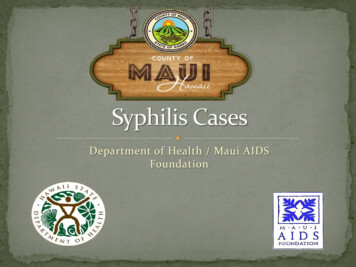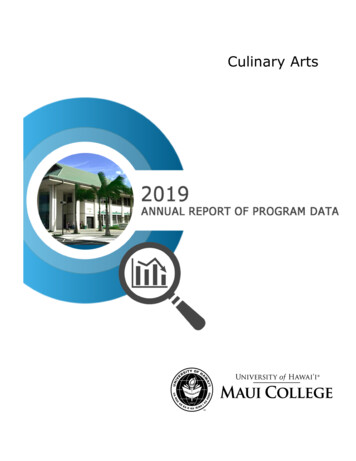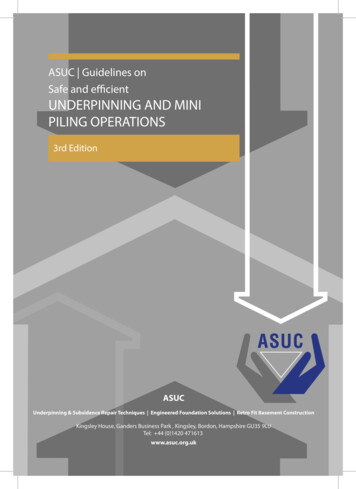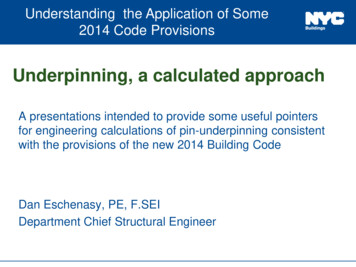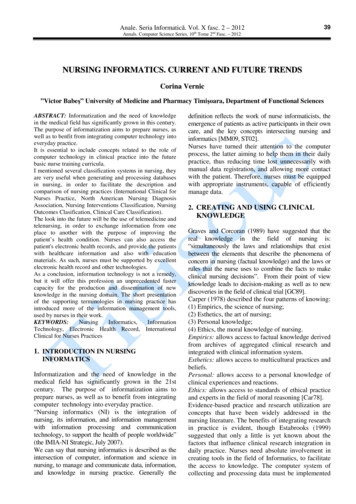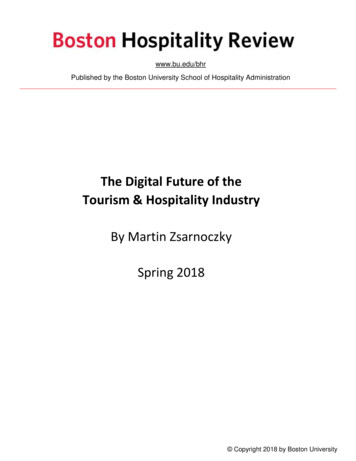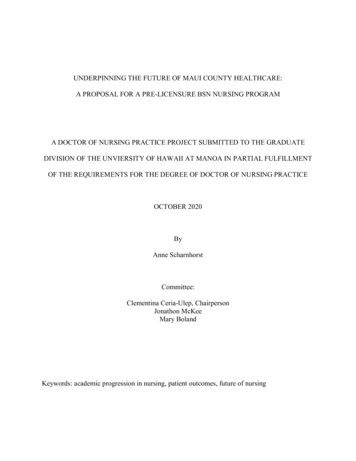
Transcription
UNDERPINNING THE FUTURE OF MAUI COUNTY HEALTHCARE:A PROPOSAL FOR A PRE-LICENSURE BSN NURSING PROGRAMA DOCTOR OF NURSING PRACTICE PROJECT SUBMITTED TO THE GRADUATEDIVISION OF THE UNVIERSITY OF HAWAII AT MANOA IN PARTIAL FULFILLMENTOF THE REQUIREMENTS FOR THE DEGREE OF DOCTOR OF NURSING PRACTICEOCTOBER 2020ByAnne ScharnhorstCommittee:Clementina Ceria-Ulep, ChairpersonJonathon McKeeMary BolandKeywords: academic progression in nursing, patient outcomes, future of nursing
UNDERPINNING THE FUTURE OF MAUI COUNTY HEALTHCAREDedicationThis project is dedicated to “the village” that is invariably required to accomplishsignificant and valuable projects. First, to my number one fan and biggest supporter, my husbandJeff: I wouldn’t even be here without your love and strength. Then to my colleagues past andpresent at the University of Hawaiʻi Maui College and in the Hawaiʻi Statewide NursingConsortium, a cadre of brilliant minds and passionate hearts too many to mention: your supportand examples make my career alive and always growing. Of course the formal AcademicProgression in Nursing (APIN) efforts from the national level at RWJF, to Dean Boland andLaura Reichhardt here in Hawaii at the Hawaii State Center for Nursing have always supportedme both with data and their passion. And ultimately to the God of creation who loves me, andkeeps me believing the best in myself, and others, and empowers me to dream big and never giveup: mahalo nui loa ke akua!ii
UNDERPINNING THE FUTURE OF MAUI COUNTY HEALTHCAREAbstractThe purpose of this evidenced based project is to provide Maui County with the benefitsof a Bachelor of Science in Nursing (BSN) prepared new Registered Nurses (RNs) by makingthe University of Hawaiʻi Maui College (UHMC) Nursing Program a BSN degree. The historyof the access to BSN education and employment in Maui County is examined as it relates toincidence of students pursuing the degree. The Academic Progression in Nursing (APIN)literature was searched over the past ten years and consistently demonstrated the benefits topatient and organizational outcomes from BSN preparation. It also outlined barriers to studentsearning this degree which are a focus of the project to overcome. The conclusion was to changethe UHMC Associate Degree in Nursing (ADN) to a pre-licensure BSN. This will provide MauiCounty with 100% BSN prepared new RNs going forward. It will ensure the community has newnurses prepared at the evidenced based standard, who are capable of providing optimum patientcare, supporting organizational standards of excellence, and being in the position to pursueadvanced practice and leadership roles as their careers develop.iii
UNDERPINNING THE FUTURE OF MAUI COUNTY HEALTHCARETable of ContentsAbstractiiiA Proposal for a Pre-licensure BSN Nursing Program at the Community College1Description of the Problem1Review of Literature2Search Strategy, Grading Tool2Synthesis of Evidence3Quality/Quantity/Consistency of Evidence, Limitations of Literature5Intervention5Conceptual Framework6PICO ect Design6Human Subject Considerations7Measurements7Data Collection Procedure8Data Analysis9Results/Evaluation9Demand9Maui BSN11Cost13Resources14iv
UNDERPINNING THE FUTURE OF MAUI COUNTY HEALTHCAREPurpose/Goals 8Implications18Discussion18DNP Essentials21References24Appendices28v
UNDERPINNING THE FUTURE OF MAUI COUNTY HEALTHCAREA Proposal for a Pre-licensure BSN Nursing Program at the Community CollegeIn 2010, the Institute of Medicine (IOM) released “The Future of Nursing: LeadingChange, Advancing Health” report. A key message was to transform nursing education includingthe recommendation to have 80% of practicing nurses be bachelor’s prepared by 2020 (the“80/20” goal). In response to this report, the Robert Wood Johnson Foundation (RWJF)partnered with the Nursing Tri-Council (the American Association of Colleges of Nursing,American Nurses Association, American Organization of Nurse Executives, and NationalLeague for Nursing) to launch the Academic Progression in Nursing (APIN) program. The goalof the program was to develop educational models that would facilitate meeting this 80/20 goal.RWJF funded nine states to innovate and collaborate over APIN. Hawaii was one of those statesas the Hawaiʻi Statewide Nursing Consortium (HSNC) was already functioning (Tse et al.,2014). The HSNC has evolved over the past decade, and it is now evident that the University ofHawaiʻi Maui College (UHMC) could extend this model to offer the Bachelor of Science inNursing (BSN) to pre-licensure nursing students. This will better serve students, healthcareproviders and organizations, and patients of Maui County.Description of the ProblemThe HSNC created a unified curriculum with the University of Hawaiʻi at Mānoa,UHMC, Kapiolani Community College, and Kauai Community College so that communitycollege students could proceed seamlessly and directly to earn their BSN. The goal was that 80%of the community college Consortium students would continue on to their BSN and support theAPIN objectives. The first cohort graduated from the HSNC BSN program in May 2013, and asof May 2018, 98 of the 322 (30%) UHMC Associate Degree in Nursing (ADN) graduates haveobtained their BSN through this program. This percent is still lower than the current Maui1
UNDERPINNING THE FUTURE OF MAUI COUNTY HEALTHCARECounty BSN percentage of 49%, and much lower than the state average of 73% (Hawaii StateCenter for Nursing, 2019). Transforming the UHMC Nursing Program into a BSN programcould address this gap by increasing BSN graduates for Maui County.The call for the BSN as the entry level for nursing practice has been in the literature forseveral decades and, as will be demonstrated in the literature review, the evidence continues tomount how important this is in order to provide safe and high quality nursing care.Review of LiteratureSearch strategyThe literature was searched using CINAHL, ERIC, Medline and PubMed. Key wordswere “academic progression in nursing,” “academic progression,” “baccalaureate education innursing and patient outcomes,” and “academic progression and nurses”. After the search returnswere reviewed, a total of 60 relevant articles were obtained. The second phase was reviewing thereference lists of these 60 articles, and this process, produced an additional 30 articles. A total of90 articles were collected. See Appendix A for the literature search details and the literaturereview matrix. Upon review of this initial set of 90, 30 articles were chosen as most relevant toform the foundation of this project.Grading toolThe Mosby’s Level of Evidence criteria (Appendix B) was used to evaluate the articles(Ackley, Swan, Ladwig, and Tucker, 2008). This tool provides seven levels of strength ofevidence starting with the strongest at Level I: Meta-analysis, down to Level VII: the opinions ofexperts. The level of evidence for the 30 reference articles ranged from Level III to VII,including several well-designed case-controlled and cohort studies, expert opinions, andundergirded by expert committees such as IOM, RWJF, and the American Association of Retired2
UNDERPINNING THE FUTURE OF MAUI COUNTY HEALTHCAREPersons (AARP). Numerous national nursing organizations also published their support andcontributions to the efforts, and many states designed and implemented projects to address theneed for BSN prepared nurses. The specific levels of evidence for each article can be found inthe Appendix B.Synthesis of evidenceConsidering the ADN degree has been the only entry into nursing practice offered fromUHMC (formerly Maui Community College) since 1972, healthcare providers and patients ofMaui County has been acculturated to this. In fact, the program and the degree has served Mauivery well for decades. The increased complexity of healthcare is undeniable and this calls for achange in preparation. The literature reveals consistent themes, including both reasons to do it,and barriers to doing it. These are the themes that undergird the project.Themes supporting the BSN degree as the best entry into practice include: improved patient outcomes (Aiken, 2014; Aiken, et al., 2014; Blegen, 2013;Kutney-Lee, Sloan, and Aiken, 2013; Liao, Sun, Yu, & Li, 2016; O’Brien,Knowlton, & Whichello, 2018; Sellers, Millenbach, Zittel, Tydings, and Murray,2014More recently, Dr. Maya Djukic and her colleagues from the Rory Meyers College of Nursing,New York University published a study in The Joint Commission Journal of Quality and PatientSafety (March, 2019). This study looked at ADN and BSN graduates on 16 quality and safetyindicators and found the BSN graduates better prepared in 12 of these areas. In addition, this gapbetween the groups has doubled over the years from 2007 to 2015. This is significant both interms of the educational preparation and that the gap continues to widen.3
UNDERPINNING THE FUTURE OF MAUI COUNTY HEALTHCARE cost savings to healthcare organizations (Yakusheva, Lindrooth, and Weiss,2014; Zimmermann, Miner, and Zittel, 2010) pipeline to leadership (Aiken, 2011; Burh, 2010) decreasing confusion as to entry level preparation (Aiken, 2011; Hicks andPatterson, 2017; Raines and Taglaireni, 2008).The numerous pathways to becoming an RN has led to confusion in the healthcare system and insociety, as well as creating diverse foundations for entry into the profession. Having all UHMCgraduates exit with the BSN will provide a consistent level of preparation of graduates to allemployers. The other main healthcare professions already require a Bachelors degree, or higher:pharmacists, physical therapists, occupational therapists, social workers and physicians. Giventhe central role nursing plays in the care of the community, they need to enter the system and thehealthcare teams equally educated.The primary barrier to attaining a BSN around the country is having access to a BSNprogram. This issue was addressed in Maui County when the HSNC was formed (Tse, et al,2014) and has contributed to increasing the number of BSN RNs in Maui. This percent hasleveled off due to employment variables. Other barriers include cost: including loss of incomeand more tuition and fees (Auerbach, Buerhaus, and Staiger, 2015; Jones-Schenk, Leafman,Wallace, and Allen, 2017; Spetz, and Bates, 2013), and time: more time devoted to school, andless time to work and to be with their families (Munkvold, Tanner, and Herinckx, 2012).Providing the BSN at UHMC, the cost will be equal to the UH RN to BSN offerings and lessexpensive than the online Universities offering the RN to BSN pathway. The proposedcurriculum would eliminate the summer course allowing students to have the opportunity towork and to spend time with families each summer.4
UNDERPINNING THE FUTURE OF MAUI COUNTY HEALTHCAREQuality/Quantity/Consistency of evidenceAs noted in the synthesis, the evidence is consistent in its recommendation to promoteBSN preparation as a means to improve patient safety and outcomes as well as reduce healthcarecosts. The evidence searched also clearly documents the barriers to students and practicingnurses getting the Baccalaureate degree as access, time and money. Addressing these barrierswill be paramount to the success of the initiative.Limitations of literatureThe discussion of what level is best for entry into practice has occurred for decades.Starting with the first American Nurses’ Association position paper in 1965 which stated that forthe beginning professional nurse, the baccalaureate degree should be the minimum preparation.Since 2010 it has taken on a renewed urgency due to the Future of Nursing report. The wave ofevidence created by the ensuing APIN initiative is being published (Close, Gorski, Sroczynski,Farmer, and Wortock, 2015; Gerardi, Farmer, and Hoffman, 2018; Giddens, Keller, andLiesveld, 2015; Pittman, Kurtzman, and Johnson, 2014; Schuler, Johnson, Stallings, and Yin,2017) and the benefits and problems related to implementation of the recommendations arestarting to be better understood. However, the individuality of the educational communities,including the socioeconomic and cultural makeup, and the existing stakeholder and financialresources, causes some difficulties when attempting to generalize solutions. Also, none of thepublished interventions included replacing a community college associate degree program with abaccalaureate program, which is the recommendation of this project.InterventionTo engage all stakeholders to support the transition of the UHMC Nursing program fromADN to BSN, with no option for associate degree stop out. Numerous states and accreditors have5
UNDERPINNING THE FUTURE OF MAUI COUNTY HEALTHCAREauthorized Community Colleges to offer bachelor’s degrees to meet workforce and studentdemand for more highly trained graduates (Russell, 2010) as partnerships with 4-year programs,or RN to BSN programs. Maui County has both the workforce and student demand for the prelicensure BSN. UHMC already has WASC Senior College and University Commission(WSCUC) accreditation, currently offering three baccalaureates, so adding the BSN is feasible.The nursing program accreditor, the Accreditation Commission for Education in Nursing(ACEN) is supportive of the transition as well. This in an effort to provide the requisite talent tothe local healthcare service organizations to meet their missions of caring for the community,and to provide students strong preparation for the stringent job demands of nursing. A logicmodel was developed to guide the project which can be found in Appendix C.Conceptual FrameworkThe Revised Iowa Model (Appendix D) uses identified triggers to guide the formation ofa team, the review of literature, and the design of an intervention to improve current practice.This Model was chosen due to its familiarity with the members on the project team as well asamong the service partner organizations. The trigger is to address the demand for the BSN by thestudents and health care providers. It is a priority as the county looks to improve the future healthof its members, and as the literature supports this approach, a demonstration project isappropriate.PICO Question/Statement of ProblemIn Maui County with 51% of BSN (or higher) prepared RNs, would there be interest inmaking the UHMC Nursing Program a BSN only, compared to offering the BSN through HSNCas currently done?6
UNDERPINNING THE FUTURE OF MAUI COUNTY HEALTHCAREPurpose/Goals/AimsThe purpose of this evidenced based project is to provide Maui County with the benefitsof BSN prepared new RNs by making the UHMC Nursing Program BSN. The project objectivesinclude: (1) Get authorization to plan from UH Chancellors, (2) Get Hawaii State Board ofNursing (BON) approval and Accrediting Commission for Education in Nursing (ACEN), (3) getWSCUC approval, (4) Design BSN Curriculum and Policies and Procedures in cooperation withHawaii Statewide Nursing Consortium (HSNC), UHMC, and Maui County stakeholders, (5)Obtain UHMC Curriculum Committee and Academic Senate Approval, and (6) Getauthorization from UH Board of Regents for Provisional Program for UHMC BSN.Methods/ProcedureProject DesignThis will be an evidence-based project design. A synthesis of the current evidence directsthe focus of this project.Human Subjects ConsiderationHuman Subjects Consideration: The author has completed the Collaborative InstitutionalTraining Initiative (CITI) Training for research ethics and compliance, and Health Portabilityand Accountability Act (HIPAA) Training on patient privacy protections. This DNP projectsinvolves making judgments about a program effectiveness and inform decisions about futureprogramming within an organization (University of Hawaii Human Studies program, personalcommunication, August 2, 2018). All these tasks are related to quality improvement and will notproduce generalizable knowledge. Thus, this project will not require IRB application and review.MeasurementsMeasurements will include examination of the following:7
UNDERPINNING THE FUTURE OF MAUI COUNTY HEALTHCARE1. Demanda. the number of students that apply to the program each year versus thenumber admitted;b. the number of students registered for the new BSN pre-requisite scienceclass;2. The number of students having gone directly on to the HSNC BSN at Manoa(enrollment average of fall 2013 to fall 2019) compared to the students to beenrolled in the BSN-leading degree at UHMC.3. Costa. to studentsb. to the institutionData Collection ProcedureData collection consisted of:1. Demanda. Collection of admission and enrollment data in the recent years as abaseline of demand for the career on the island.b. Collection of enrollment data to the biochemistry course which is a newprerequisite for the UHMC BSN.2. Document the number of students enrolled in the Manoa HSNC BSN fromUHMC between 2013 and 2020. There will be 30 BSN spots available in theprogram.3. Cost8
UNDERPINNING THE FUTURE OF MAUI COUNTY HEALTHCAREa. Perform a cost analysis between the ADN at UHMC compared to otherpre-licensure BSN programs and RN to BSN programs.b. Compare ADN cost to UHMC with proposed cost of BSN program.Data AnalysisTo understand the need for the BSN by Maui County, a picture of the recent past, thecurrent status, and a future scenario must be seen. Not only has the health care community beenasking for Baccalaureate preparation of new graduate nurses, the student demand for the degreeis clear. As will be demonstrated, the UHMC students were actively pursuing this degree untilthey were faced with the pressures of becoming a newly hired RN. The competing priority offinancial stability overshadowed their self-assessed need to be better prepared. As such, cost isan important variable to address when designing the pre-licensure BSN program. In addition, thecurrent financial crisis in the state requires that cost be specifically outlined as a part of thefeasibility and sustainability planning for the University during the pandemic and post-pandemiclean years.Results and EvaluationDemandThe broad based community support this project has engendered is noteworthy. Themembers of the UHMC Nursing Advisory Committee, which includes representation from MauiMemorial Medical Center (MMMC), Kaiser clinics, Maui DOH, Maui Medical Group, and HaleMakua all support BSN preparation for new nurses. The advisory board, as evidenced byminutes, have stated a preference for BSN prepared new graduates versus ADN only graduates.They concur that the role is becoming increasingly complex and the additional preparation isbecoming critical to new graduate onboarding to ensure the healthcare organizations can9
UNDERPINNING THE FUTURE OF MAUI COUNTY HEALTHCAREmaintain safety and quality while controlling costs. This is in line with the findings of theliterature search. At the last UHMC Nursing Advisory Committee meeting on August 12, 2020,with the announcement of the delay of the start date to 2022, the desire for BSN was reiteratedespecially in the face of the COVID-19 events and evolving impact on the nursing workforce.The demand for the UHMC nursing program has been consistently high. With theeconomy in a historic downturn, and unemployment at historic highs, the demand for healthcaresector jobs will only continue to increase. The past four years are consistent with the trends ofthe past two decades at UHMC:YearAdmitted pplicants98846885Admitted404030 ( 10 LPNs)30 ( 10 LPNs)Since the projected rollout of the BSN program was Fall 2021, it was anticipated amongthe students preparing to apply for nursing that the January 31, 2021 admission deadline wouldbe for BSN. The nursing academic counselor had been advising students for BSN prerequisitessince fall 2019 when the curriculum was solidified. One course that was added to theprerequisites for BSN, that was not r
Center for Nursing, 2019). Transforming the UHMC Nursing Program into a BSN program could address this gap by increasing BSN graduates for Maui County. The call for the BSN as the entry level for nursing practice has been in the literature for several decades and, as will be demonst

